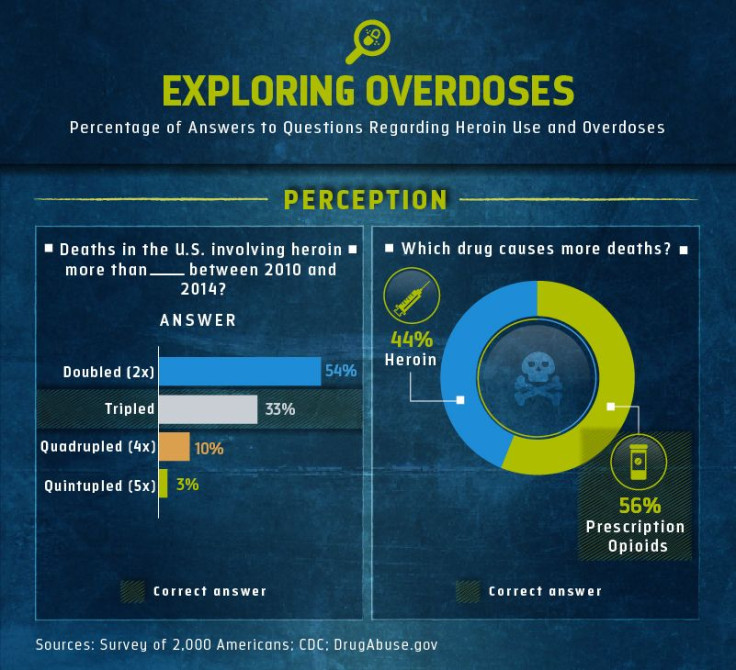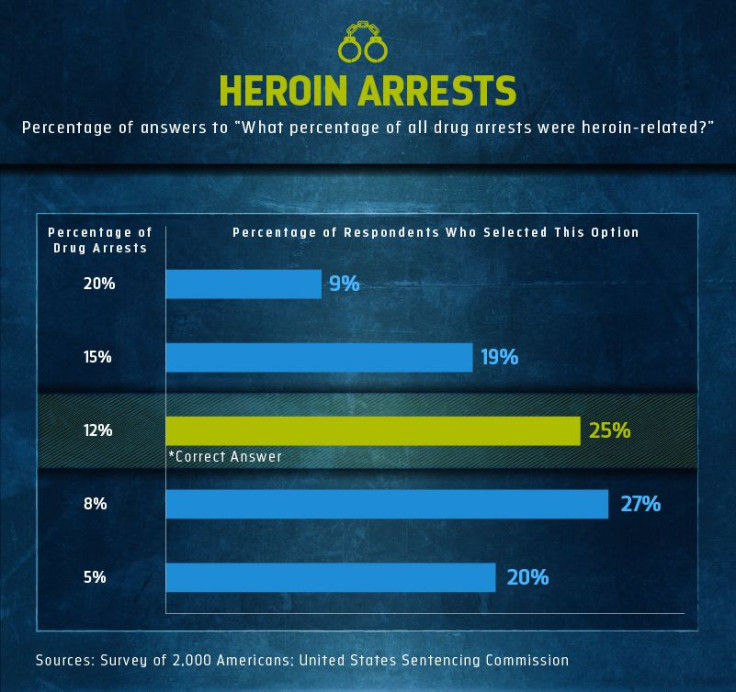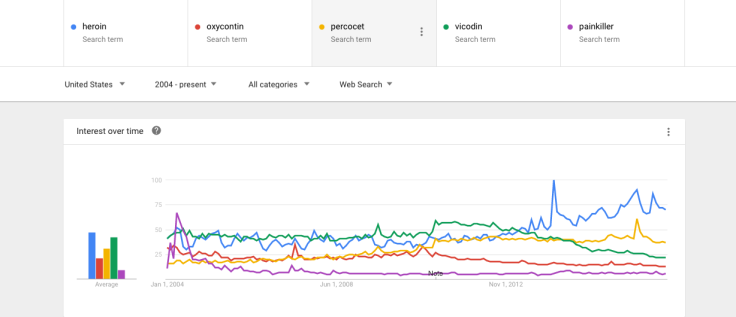Heroin-Opioid Addiction Epidemic: Americans Need Work On Drug Abuse Awareness, Study Says

The heroin epidemic has spread across the nation, but Americans might not know much about the drug problem, a new survey shows.
Heroin addiction, once seen as a problem for big cities, has taken its toll on small communities across the country. However, according to a new survey provided by Heroin.net, Americans are misinformed about the issue. The company, which works with treatment centers across the country to help those with addiction problems, collects data from academic research papers, government websites and other sources.
In the Heroin.net survey, 2,000 Americans were asked about the heroin epidemic. Here is what they responded:
Which Region Suffers The Most From Heroin?
Heroin addiction has spread throughout the 2000s and 2010s across large and small U.S. communities, the report points out. However, states in the Northeast, such as Vermont, New Hampshire, Pennsylvania and New York have had more media coverage when it comes to the heroin epidemic because of drug trafficking and abuse in the region.
While headlines focus on the Northeast, the region most affected by heroin is the Midwest. The Midwest slightly overtakes the Northeast when it comes to the number of heroin-associated deaths per 100,000 residents. For example, in Ohio, at least 23 people die of heroin-related incidents every week, making the state the most affected by heroin addiction. Cities in Indiana have also seen a spike in the number of heroin overdoses, many of them fatal.
In the survey, most of the respondents believed the Northeast was hit the hardest by heroin addiction. Those from the West, Southwest, Southeast and the Northeast itself stated this area was the most affected by the heroin crisis, while those in the Midwest correctly responded their region was hit the hardest.

Heroin-Related Deaths In The U.S.
The problem in the Midwest isn’t isolated. Every region in the country has seen a jump in heroin related-deaths from 2000 through 2013. The rate of drug-overdose deaths has increased overall by 137 percent, with the rate of overdose deaths involving opioid pain relievers and heroin rising by 200 percent since 2000, according to the Centers for Disease Control and Prevention.
The survey asked participants how much they believed heroin-related deaths have risen from 2010 to 2014 -- Most of them got the answer wrong.
The majority of respondents (54%) believed the number of deaths have doubled, but they have actually tripled. Thirty-three percent of respondents correctly stated that heroin deaths had tripled over the four-year period.
However, respondents answered correctly when asked whether heroin or prescription opioids caused more deaths. Fifty-six percent accurately stated prescription opioids caused more fatalities, compared 44 percent who believed it was heroin.

Heroin-Related Arrests
When it comes to drug-related arrests, respondents highly underestimated heroin, with only one in four accurately answering that 12 percent of drug arrests are linked to heroin.
The misperception could be caused by where people think drug abuse happens. In a 2014 Pew Research Center survey, 87 percent of respondents said they saw drug abuse as a serious problem or crisis on the national scale. However, 47 percent of participants said drug abuse was not a problem or identified it as a minor problem when thinking locally. This means Americans think drug-related crime happens elsewhere, rather than in their own neighborhoods.

Public Interest in Heroin Epidemic
Overall, public interest in heroin has steadily increased over the past several years, especially in 2014, Google trends data shows. However, the amount of Google searches for prescription opioids like OxyContin, Percocet, Vicodin, and "painkiller" have remained the same or declined. The difference suggests Americans are not completely aware that prescription opioids often lead to heroin addiction.
“Heroin use and prescription opioid abuse are related phenomena,” says the report by Heroin.net. “These substances can each fulfill the same physical addiction, and users of one may transition to the other if necessary.”
Patients are misusing prescription painkillers, which leads to addictions and heroin use, research compiled by the American Society of Addiction Medicine suggests. F our out of five new heroin users started addiction by misusing prescription painkillers.
“Heroin and prescription opioids both possess a high risk for dependence,” said a spokesperson from Heroin.net. “However, there is a general misperception that prescription opioids are safe because they are prescribed by a doctor.”

Opioid deaths have surpassed gun homicides for the first ever in the U.S., as more Americans died from heroin-related incidents than from gun homicides in 2015. The numbers are a stark opposite compared to just a few years ago in 2007 when gun homicides outnumbered heroin deaths by more than five to 1 one.
Officials found drug overdose deaths have become the leading cause of injury death in America, exceeding the number of deaths by motor vehicles and firearms every year since 2008, the DEA’s 2015 National Drug Threat Assessment shows.
The survey shows people understand the heroin epidemic is a major problem, but at the same time they need to look into the issue more.
“While our survey respondents answered incorrectly about the specifics of the heroin epidemic, we found that they generally understood the immensity of the issue,” said a spokesperson for Heroin.net. “However, our survey results indicate that Americans can do more to learn about the specifics of the issue.”
© Copyright IBTimes 2024. All rights reserved.











